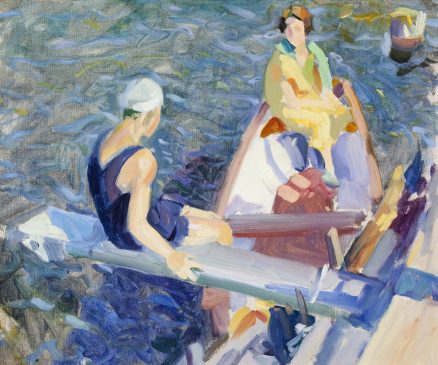- Categories
- Figural works
- Women
- Zoom in on Artwork
- Print Page
- Email Page to Friend
Edgar Rupprecht painted this study in preparation for one of the most important works of his early career, The Diving Board (circa 1922; location unknown). Closely following the composition of the study, the finished painting pictures a scene of casual interaction between a young woman in a rowboat and a swimmer seated on a diving board. The swimmer’s back is to the viewer, a bystander to the conversation who looks down on the figures from the dock glimpsed at lower right. The final work clearly shows the girl’s smiling expression as she looks toward her companion. This emphasis on the figures’ implied interaction is absent in the study: here, her facial features are barely indicated and forms are simplified to broad strokes and strong color contrasts, with the sharply tipped-up perspective enhancing the effect of an abstract composition. The background is a lively pattern of fluid light-blue lines applied over a thin gray wash, capturing the water’s shifting play of broken surface reflections against murky depths. The quickly painted study was probably made on the spot to capture the essentials of color, light, and form.
The Diving Board was shown in the Art Institute of Chicago’s 1923 “Chicago and Vicinity” exhibition, where it garnered the Marshall F. Holmes Prize of one hundred dollars for a work in “color design.” It was one of two paintings cited by the reviewer for The Catholic World as “happy subjects, happily treated and quite deserving of their awarded prizes.”i The Chicago Evening Post Magazine of the Art World reproduced the painting in 1925 and again in 1927, the last when it was part of an exhibition held on Municipal Pier (now Navy Pier), on Chicago’s lakefront, organized by the Commission for the Encouragement of Local Art.
Rupprecht painted The Diving Board in rural Saugatuck, on the Michigan shore of Lake Michigan. There, along with Arthur K. Houlberg, he attended the Summer School of Painting at Saugatuck (now known as Ox-Bow) early in his artistic education. Rupprecht soon became an assistant to its principal teacher, Frederick Fursman, and eventually a leading faculty member at Saugatuck and at the Art Institute, with which the summer school was affiliated. The school was located between the Kalamazoo River and a lagoon near the Lake Michigan shore, offering abundant opportunities for summertime recreation as well as outdoor painting. Rupprecht made at least one other image that celebrates the leisurely vacation atmosphere of Saugatuck, The Summer Visitor (Union League Club of Chicago), which he painted in the wake of the success of The Diving Board, closely following its subject and composition.
Wendy Greenhouse, PhD
Donated by M. Christine Schwartz to the Saugatuck-Douglas History Center, Douglas, Michigan, in 2021
i Alice G. Hayde, “Exhibition by Artists of Chicago and Vicinity,” The Catholic World, Feb. 1923.
